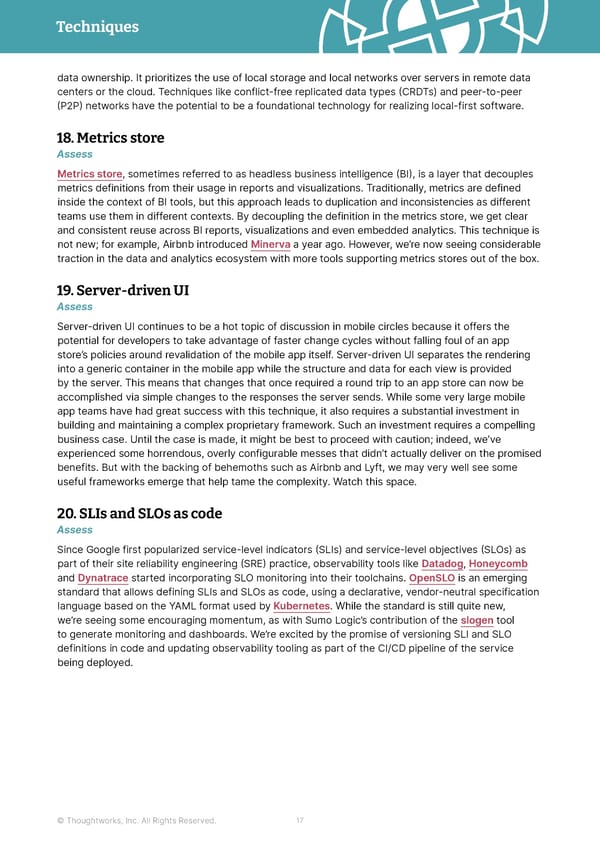Techniques Thoughtworks Technology Radar data ownership. It prioritizes the use of local storage and local networks over servers in remote data centers or the cloud. Techniques like conflict-free replicated data types (CRDTs) and peer-to-peer (P2P) networks have the potential to be a foundational technology for realizing local-first software. 18. Metrics store Assess Metrics store, sometimes referred to as headless business intelligence (BI), is a layer that decouples metrics definitions from their usage in reports and visualizations. Traditionally, metrics are defined inside the context of BI tools, but this approach leads to duplication and inconsistencies as different teams use them in different contexts. By decoupling the definition in the metrics store, we get clear and consistent reuse across BI reports, visualizations and even embedded analytics. This technique is not new; for example, Airbnb introduced Minerva a year ago. However, we’re now seeing considerable traction in the data and analytics ecosystem with more tools supporting metrics stores out of the box. 19. Server-driven UI Assess Server-driven UI continues to be a hot topic of discussion in mobile circles because it offers the potential for developers to take advantage of faster change cycles without falling foul of an app store’s policies around revalidation of the mobile app itself. Server-driven UI separates the rendering into a generic container in the mobile app while the structure and data for each view is provided by the server. This means that changes that once required a round trip to an app store can now be accomplished via simple changes to the responses the server sends. While some very large mobile app teams have had great success with this technique, it also requires a substantial investment in building and maintaining a complex proprietary framework. Such an investment requires a compelling business case. Until the case is made, it might be best to proceed with caution; indeed, we’ve experienced some horrendous, overly configurable messes that didn’t actually deliver on the promised benefits. But with the backing of behemoths such as Airbnb and Lyft, we may very well see some useful frameworks emerge that help tame the complexity. Watch this space. 20. SLIs and SLOs as code Assess Since Google first popularized service-level indicators (SLIs) and service-level objectives (SLOs) as part of their site reliability engineering (SRE) practice, observability tools like Datadog, Honeycomb and Dynatrace started incorporating SLO monitoring into their toolchains. OpenSLO is an emerging standard that allows defining SLIs and SLOs as code, using a declarative, vendor-neutral specification language based on the YAML format used by Kubernetes. While the standard is still quite new, we’re seeing some encouraging momentum, as with Sumo Logic’s contribution of the slogen tool to generate monitoring and dashboards. We’re excited by the promise of versioning SLI and SLO definitions in code and updating observability tooling as part of the CI/CD pipeline of the service being deployed. © Thoughtworks, Inc. All Rights Reserved. 17
 Vol 27 | Technology Radar Page 16 Page 18
Vol 27 | Technology Radar Page 16 Page 18